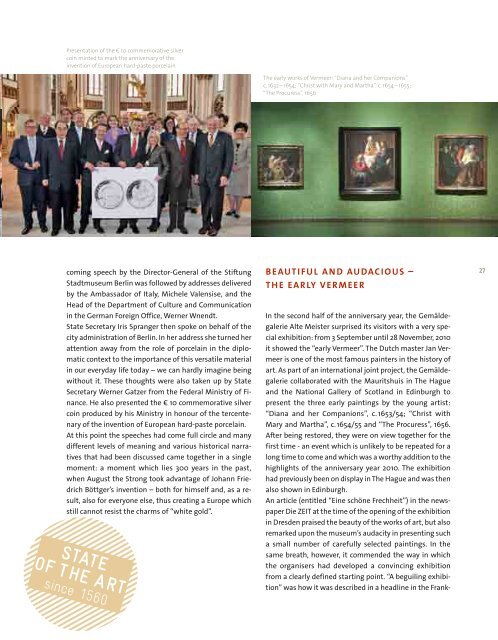Annual Report 2010 - Staatliche Kunstsammlungen Dresden
Annual Report 2010 - Staatliche Kunstsammlungen Dresden
Annual Report 2010 - Staatliche Kunstsammlungen Dresden
Create successful ePaper yourself
Turn your PDF publications into a flip-book with our unique Google optimized e-Paper software.
Presentation of the € 10 commemorative silver<br />
coin minted to mark the anniversary of the<br />
invention of European hard-paste porcelain<br />
coming speech by the DirectorGeneral of the Stiftung<br />
Stadtmuseum Berlin was followed by addresses delivered<br />
by the Ambassador of Italy, Michele Valensise, and the<br />
Head of the Department of Culture and Communication<br />
in the German Foreign Office, Werner Wnendt.<br />
State Secretary Iris Spranger then spoke on behalf of the<br />
city administration of Berlin. In her address she turned her<br />
attention away from the role of porcelain in the diplomatic<br />
context to the importance of this versatile material<br />
in our everyday life today – we can hardly imagine being<br />
without it. These thoughts were also taken up by State<br />
Secretary Werner Gatzer from the Federal Ministry of Finance.<br />
He also presented the € 10 commemorative silver<br />
coin produced by his Ministry in honour of the tercentenary<br />
of the invention of European hardpaste porcelain.<br />
At this point the speeches had come full circle and many<br />
different levels of meaning and various historical narratives<br />
that had been discussed came together in a single<br />
moment: a moment which lies 300 years in the past,<br />
when August the Strong took advantage of Johann Friedrich<br />
Böttger’s invention – both for himself and, as a result,<br />
also for everyone else, thus creating a Europe which<br />
still cannot resist the charms of “white gold”.<br />
The early works of Vermeer: “Diana and her Companions”<br />
c. 1632 – 1654; “Christ with Mary and Martha”, c. 1654 – 1655;<br />
“The Procuress”, 1656<br />
B eAutI Fu l An D Au DACIouS –<br />
tH e eARlY VeRMeeR<br />
In the second half of the anniversary year, the Gemäldegalerie<br />
Alte Meister surprised its visitors with a very special<br />
exhibition: from 3 September until 28 November, <strong>2010</strong><br />
it showed the “early Vermeer”. The Dutch master Jan Vermeer<br />
is one of the most famous painters in the history of<br />
art. As part of an international joint project, the Gemäldegalerie<br />
collaborated with the Mauritshuis in The Hague<br />
and the National Gallery of Scotland in Edinburgh to<br />
present the three early paintings by the young artist:<br />
“Diana and her Companions”, c. 1653/54; “Christ with<br />
Mary and Martha”, c. 1654/55 and “The Procuress”, 1656.<br />
After being restored, they were on view together for the<br />
first time an event which is unlikely to be repeated for a<br />
long time to come and which was a worthy addition to the<br />
highlights of the anniversary year <strong>2010</strong>. The exhibition<br />
had previously been on display in The Hague and was then<br />
also shown in Edinburgh.<br />
An article (entitled “Eine schöne Frechheit”) in the newspaper<br />
Die ZEIT at the time of the opening of the exhibition<br />
in <strong>Dresden</strong> praised the beauty of the works of art, but also<br />
remarked upon the museum’s audacity in presenting such<br />
a small number of carefully selected paintings. In the<br />
same breath, however, it commended the way in which<br />
the organisers had developed a convincing exhibition<br />
from a clearly defined starting point. “A beguiling exhibition”<br />
was how it was described in a headline in the Frank<br />
27

















